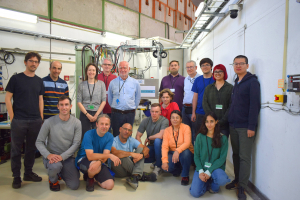IFIC drives next-generation instrumentation to explore quantum physics in extreme electromagnetic fields and future colliders
The joint center of the Spanish National Research Council (CSIC) and the University of Valencia (UV) strengthens its leadership in advanced instrumentation through its key participation in the international experiment LUXE [1], which will investigate for the first time in the laboratory quantum electrodynamics phenomena in strong fields (SFQED).
The experiment, to be conducted at the DESY facility in Germany, will recreate extreme conditions previously only observed indirectly in astrophysical environments, such as those near neutron stars. By combining high-energy accelerators and ultra-intense lasers, LUXE will enable the study of fundamental quantum processes in regimes never before explored experimentally—approaching the quantum limit where electron-positron pairs are spontaneously created from the vacuum (known as the Schwinger limit [2]).
Since 2020, the IFIC team led by Adrián Irles, from the AITANA group, has spearheaded the development of high-granularity electromagnetic calorimeters in Spain—a key technology for both LUXE and future electron-positron colliders. In 2021, the group became actively involved in the creation of CERN’s DRD6 collaboration on R&D in calorimetric detectors, officially established in 2024. In 2022, IFIC formally joined the LUXE collaboration, taking a leading role in the design, integration, and construction of these detection systems.
In June 2025, this effort reached a milestone [3] with a successful test beam campaign at DESY-II, where a prototype calorimeter with alternating layers of silicon and compact tungsten was tested. The system—whose sensors were entirely assembled and characterized at IFIC—collected over 380 million events, synchronized with a beam telescope system based on ALPIDE sensors, the most advanced of its kind in Europe.
The prototype was developed in collaboration with international groups from the University of Warsaw, AGH University of Krakow, Tel Aviv University, DESY, and the Institute of Space Science in Bucharest. IFIC was responsible for the high-precision mechanical design and ultra-compact assembly of large-area sensors, a task supported by its new cleanroom TARDIS-Lab [4]. This facility enables silicon sensor characterization, integration, and testing under controlled conditions, consolidating IFIC as a reference center in this area.
The instrumentation developed for LUXE and DRD6 is also strategically essential for the detectors of future linear and circular colliders, known as Higgs Factories, not only for Higgs boson physics and Beyond the Standard Model studies but also for luminosity measurement systems in the forward regions of detectors [5].“Only by strengthening and supporting work in instrumentation can we give ourselves the ability to decide what physics we want to do today and in the future,” says Irles. “That’s why I believe this project is so attractive to young people, both at IFIC and beyond.”
IFIC’s leadership in this field is reinforced by its prominent role in CERN’s DRD6 collaboration, focused on R&D in calorimetric detectors, where Adrián Irles serves as deputy coordinator of the high-granularity calorimetry working group.
This achievement reflects how strategic, sustained investment in R&D&I for detector technologies, combined with active participation in international collaborations, places IFIC at the core of scientific transformations in contemporary particle physics.
References:
[1] “Technical Design Report for the LUXE experiment” Eur.Phys.J.ST 233 (2024) https://link.springer.com/article/10.1140/epjs/s11734-024-01164-9
[2] “On gauge invariance and vacuum polarization” Phys.Rev. 82 (1951) 664-679 https://journals.aps.org/pr/abstract/10.1103/PhysRev.82.664
[3] La sala limpia del Laboratorio 133, también conocida como TARDIS-Lab porque “es más grande por dentro que por fuera” https://en.wikipedia.org/wiki/TARDIS
[4] “IFIC and its international partners meet a milestone in detector instrumentation for LUXE and beyond” https://aitanatop.ific.uv.es/aitanatop/milestone-luxe-ecalp/
[5] Some examples:
- “International Large Detector: Interim Design Report” https://arxiv.org/abs/2003.01116
- “The ILD Detector: A Versatile Detector for an Electron-Positron Collider at Energies up to 1 TeV” https://arxiv.org/abs/2506.06030
- “Novel silicon and GaAs sensors for compact sampling calorimeters” Eur.Phys.J.C 85 (2025) 6, 684 https://link.springer.com/article/10.1140/epjc/s10052-025-14341-4
- “A proposal for the Lohengrin experiment to search for dark sector particles at the ELSA Accelerator” Eur.Phys.J.C 85 (2025) 5, 600 https://link.springer.com/article/10.1140/epjc/s10052-025-14257-z
- “A Silicon-Tungsten ECAL for the FCC Detectors” https://indico.cern.ch/event/1529896/contributions/6436820/attachments/3036750/5363080/2025%E2%88%9201_FCC_EoI_det_SiW_ECAL_v4-040225.pdf
- “Expression of Interest: Development of a Compact SiW Luminosity Calorimeter for FCC-ee Detectors”




















